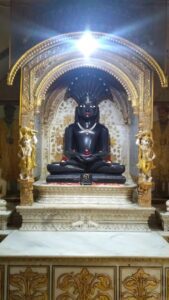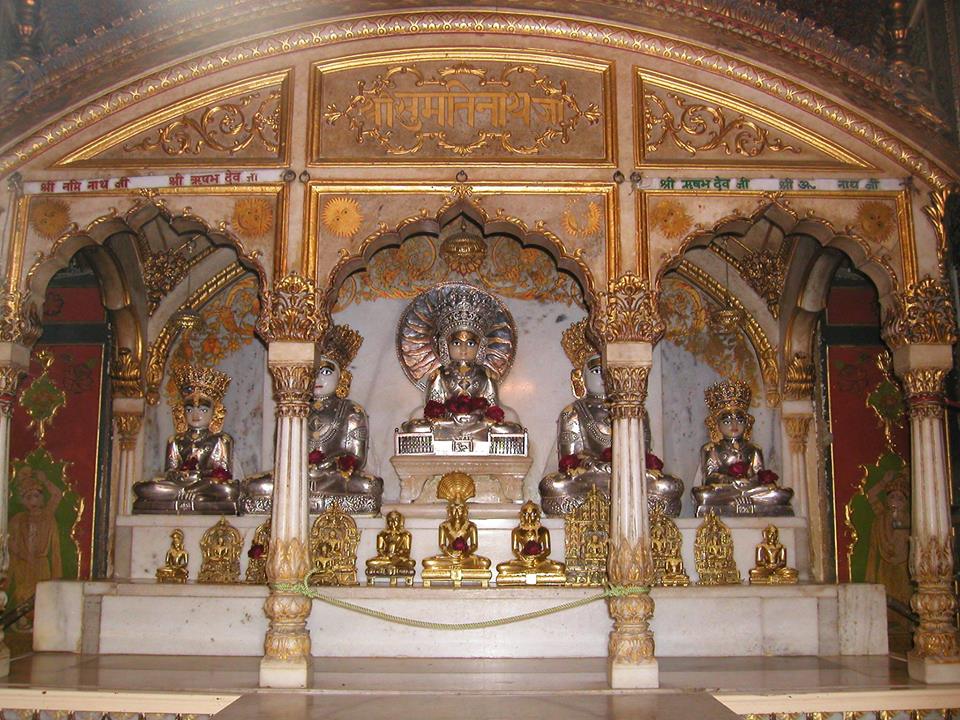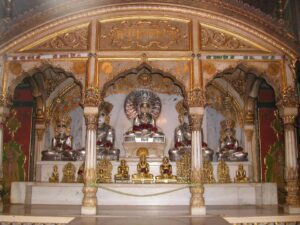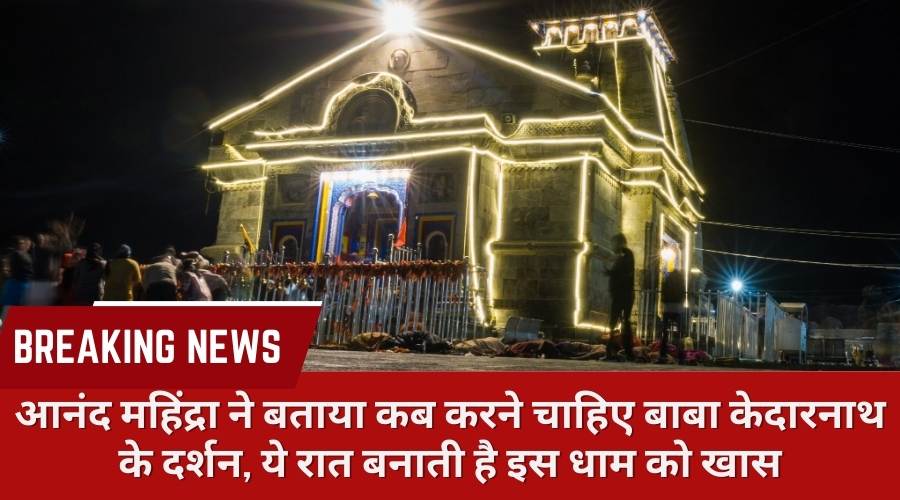Sumantinath Shwetamber Jain Temple in Delhi
Shwetamber Jain Temple is a Majestic Temple located in the Kinari Bazaar of Chandni Chowk area in Old Delhi. It is a three-storeyed marble building that is one of the most lavishly decorated Jain temples with sophisticated artwork.
Delhi, the capital of India, is renowned for its rich historical and cultural heritage. Amidst the bustling streets and modern structures, numerous architectural marvels showcase the city’s religious diversity. Among these magnificent structures stands the Sumantinath Shwetamber Jain Temple, a sacred place of worship that exudes tranquility and spiritual solace. Let’s embark on a virtual journey to explore the captivating beauty and significance of this Jain temple in Delhi.
It is believed by the Jain Sect that the temple was founded during the era of Mahabharata and was shaped majestically during the Mughal era. According to the sources the Pandavas are believed to be Jains and devotees of the 5th Tirthankar Sumantinatha.
Shwetamber means white-clad. The priests inside the temple wear a white dress, which they believe is a way to achieve liberalization by living an ascetic life.
The main devotional area of the temple is on the first floor and has a beautiful idol of Lord Parasnath. Statues of Lord Sumatinath and Lord Adinath with other pivotal figures of Jainism are in the main temple building area. Arched entrances, filled with elegant paintings and gold filigree work make up the interiors of the temple.
Another attraction of this beautiful temple is the Detailed paintings depicting the life of Lord Mahavira, along with the paintings of musicians and dancers. The Jain Shwetambar Temple has a museum on the ground floor that contains old artifacts, manuscripts, paintings in gold, and many items made out of silver.

Information: Sumantinath Shwetamber Jain Temple in Delhi
Schedule and timings: Open on all the days of the week from 6 AM to 8 PM
Entrance Fees: Free for Everybody
Ways to reach Shwetamber Jain Temple in Delhi:
- From Kashmere Gate ISBT
- Go to the Kashmere Gate metro station.
- From there take the Yellow line at Platform 1 Chandni Chowk.
- After arriving at Chandni Chowk metro station, leave the station, and the Shwetamber Jain Temple is approximately 550 Mts.
- From New Delhi Railway Station
- Go to the New Delhi Metro Station.
- Take the Yellow Line at Platform 2 towards Chandni Chowk.
- After arriving at Chandni Chowk metro station, leave the station, and the Shwetamber Jain Temple is approximately 550 Mts.
- From IGI Airport
- Go to the Indigo Terminal 1 at the airport.
- Take the Magenta line at Platform 1 towards Hauz Khas.
- After arriving at Hauz Khas, take the Yellow Line at platform 2 towards Chandni Chowk.
- After arriving at Chandni Chowk metro station, leave the station, and the Shwetamber Jain Temple is approximately 550 Mts.
History of Shwetamber Jain Temple:
The Shwetambar Jains are one of the two major sects within Jainism, the other being the Digambar Jains. The term “Shwetambar” translates to “white-clad,” referring to the white garments worn by the followers of this sect. The history of the Shwetambar Jains is deeply intertwined with the development and evolution of Jainism as a whole.
Origin and Early Development:
Jainism, as a religion, traces its roots back to ancient India. The founder of Jainism is believed to be Lord Rishabhdeva, also known as Adinath, who lived in the prehistoric period. However, the historical development of Jainism as an organized religion began with the 23rd Tirthankara, Lord Parshvanath, who lived around the 9th century BCE.
During the time of Lord Mahavir, the 24th and final Tirthankara, who lived in the 6th century BCE, Jainism witnessed significant growth and development. It was during this period that the basic principles and teachings of Jainism were formalized, emphasizing non-violence, truthfulness, non-attachment, and compassion towards all living beings.
Split and Emergence of Shwetambar Sect:
Following the passing of Lord Mahavir, a significant division emerged within the Jain community. The division was primarily based on differences in beliefs and practices regarding the use of clothing and possession of material possessions.
The Shwetambar sect emerged as a result of this division. According to Shwetambar’s belief, Lord Mahavir’s teachings were preserved orally and passed down through generations by a series of learned monks and nuns. They believe that the original scriptures, known as the “Agamas,” were lost over time, leading to the reliance on oral tradition.
Beliefs and Practices:
Shwetambar Jains believe in the attainment of liberation or Moksha through strict adherence to the principles of Jainism. They place great emphasis on asceticism, practicing self-discipline, and renouncing worldly attachments. While some Shwetambar Jains opt for an ascetic lifestyle, others follow a layperson’s path, leading lives of piety, compassion, and ethical conduct.
Unlike Digambar Jains, who traditionally believe in complete nudity as a symbol of renunciation, Shwetambar Jains wear simple, white garments. This attire is symbolic of their commitment to modesty and detachment from worldly possessions.
Shwetambar Jains have a strong tradition of worship and devotion. They build and maintain temples dedicated to Tirthankaras and other revered Jain figures. Temples serve as centers for rituals, prayers, and spiritual gatherings. Shwetambar Jains also emphasize the importance of pilgrimage to sacred Jain sites as a means of deepening their faith and seeking spiritual enlightenment.
Significant Figures and Contributions:
Throughout history, the Shwetambar community has produced many notable figures who have made significant contributions to Jainism and Indian society. Prominent Jain scholars, philosophers, and reformers such as Acharya Hemachandra, Acharya Kundakunda, and Acharya Siddhasena Divakara have played crucial roles in advancing Jain philosophy, literature, and ethical teachings.
Shwetambar Jains have also been instrumental in the establishment of educational institutions, hospitals, and charitable organizations, reflecting their commitment to the service and welfare of society.
Architectural Splendor:
The architectural style of the Sumantinath Shwetamber Jain Temple is a blend of North Indian and Rajasthani influences. Constructed with red sandstone and adorned with intricate carvings, the temple’s exterior is a feast for the eyes. The main shrine, or sanctum sanctorum, houses a magnificent idol of Lord Sumantinath, crafted with white marble and exquisitely decorated with precious gems.
Inside the Temple Complex:
As one enters the temple complex, they are greeted by a series of beautifully sculpted pillars and intricately carved arches. The halls and courtyards of the temple are adorned with intricate frescoes and paintings depicting scenes from Jain mythology and the lives of the Tirthankaras. The serenity and spiritual aura of the temple complex create a tranquil atmosphere, encouraging introspection and meditation.
Preserving Jain Heritage:
The Sumantinath Shwetamber Jain Temple not only serves as a place of worship but also plays a crucial role in preserving the cultural and artistic heritage of the Jain community. The temple hosts regular religious discourses, lectures, and workshops to promote Jain philosophy and teachings. It also conducts various charitable activities, contributing to the welfare of the society at large.
Hotels Near Shwetamber Jain Temple in Delhi
- Haveli Dharampura – A 3 Star Hotel in the vicinity of the temple. This hotel is exactly 750 Mts from the temple and offers various amenities and facilities keeping the luxury in mind. A staycation at Haveli Dharampura ensures you experience all of Old Delhi under one roof. A heritage traveler’s dream, the rooms feature traditional interior designs within the shell of modern amenities. The Mughal era vibe is strongly celebrated and nurtured at the haveli, with classical Kathak to be experienced every Saturday and Sunday. Get mesmerized by the rhythmic and graceful performances of Kathak set amid the impressive backdrop of the haveli, and feast on the seven-course chef’s tasting.
- Hotel Le Mem – This hotel is located in the Chandni Chowk area and is approximately 1.4 Km from the temple. This hotel has luxurious rooms with facilities like restaurants, currency exchange, and 24/7 power backup.
- Hotel Taj Mahal – Located on church mission road, this hotel is for budget travelers. It Provides the basic amenities 24/7 power backup, restaurant, and parking facilities. We recommend that guests must go through traveler reviews and ratings posted by fellow travelers to ensure that Hotel Le Mem is best suited for them.
- Hotel New Royal – One of the best budget hotels near the temples, It has one of the highlighted amenities like doctors on call, 24/7 power backup, parking facilities, and a Lift.
- Hotel Welcome Deluxe – Located in Chandni Chowk, is a budget-friendly hotel for tourists. It offers comfortable rooms along with top amenities.
Places to visit near Shwetamber Jain Temple:
- Red Fort – Located just 3 Km away from the Jain Temple is Mughal architecture representing the apex of the Mughal Empire in India.
- Gurudwara Sis Ganj Sahib – Located just 2 Km away from the Jain Temple, marks the martyrdom of Guru Teg Bahadur a Sikh Guru, and is also one of the ninth historical Sikh buildings.
- India Gate – It is one of the important Places in India that commemorates and celebrates the lives of soldiers who achieved veergati fighting for the British in World War 1.
- Gurudwara Bangla Sahib – It is one of the important Gurudwaras in India. It is known for its beautiful architecture. Located 4.6 Km away from the Jain Temple at Connaught Place.
- Agrasen ki Baoli – It is one of India’s oldest monuments and steps well, It’s famous for its beautiful architecture and now serves as a tourist spot. It is located 5.5 Km from the Jain Temple.
FAQs
Q1: What are the visiting hours of Shwetamber Jain Temple?
A: It is open on all days of the week from 6 AM to 8 PM
Q2: Is there an entry fee to visit Shwetamber Jain Temple?
A: There is no entry fee to visit the Shwetamber Jain temple.
Q3: Can we take photographs inside the Shwetamber Jain Temple?
A: Yes, photography and mobile phones are allowed.
Q4: Can we bring outside food inside the Shwetamber Jain Temple?
A: No, outside food is not allowed inside the temple premises.
Q5: Are there any specific guidelines for visiting Shwetamber Jain Temple with children?
A: Children are welcome to visit Shwetamber Jain Temple. They must be accompanied by adults and also should follow the rules and regulations.





















